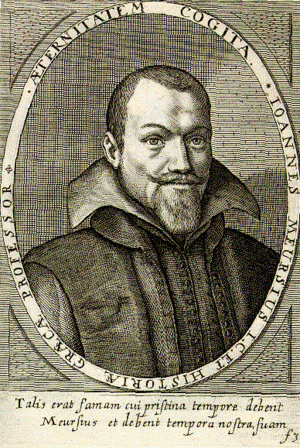Johannes Meursius facts for kids
Johannes Meursius (also known as Johannes van Meurs) was a very smart Dutch scholar who lived a long time ago, from 1579 to 1639. He was an expert in classical studies, which means he deeply understood ancient Greek and Roman languages and cultures. He also loved studying old things and history.
About Johannes Meursius
Johannes van Meurs was born in a place called Loosduinen, near The Hague in the Netherlands. He was incredibly smart from a young age. When he was just sixteen, he wrote a detailed explanation about an old Greek poem!
For ten years, Johannes was a private teacher, or tutor, for the children of Johan van Oldenbarnevelt. Oldenbarnevelt was an important Dutch leader. Johannes traveled with the family on many special trips to different countries in Europe. These were called diplomatic missions, where Oldenbarnevelt met with other leaders. During one of these trips in 1608, Johannes earned a special degree in Law from a university in France.
His Work as a Professor
In 1610, Johannes Meursius became a professor at Leiden University in the Netherlands. He taught Greek and history. The very next year, he was chosen to be the official historian for the Dutch government, known as the States-General of the Netherlands. This was a very important job!
Later, in 1619, Oldenbarnevelt, the leader Johannes worked for, faced some political problems and was executed. Even though Johannes tried to stay out of the political and religious arguments of the time, some people thought he supported Oldenbarnevelt's ideas. Because of this, his job at Leiden University became difficult.
So, in 1625, Johannes accepted a new offer from Christian IV of Denmark, the King of Denmark. He moved to Sorø in Denmark and became a professor of history and politics there. He also became the official historian for the Danish King. In this role, he wrote a long history of Denmark in Latin, called Historia Danica, which he worked on from 1630 to 1638. He lived in Sorø until he passed away in 1639.
His Writings
Johannes Meursius wrote many books and studies about classical topics. Even though his writings could sometimes be a bit disorganized, they are full of valuable information about ancient times. He also wrote about the political challenges happening in the Netherlands during his life.
One of his important works was the Glossarium graeco-barbarum. This was one of the first dictionaries that helped people understand Modern Greek, which was different from ancient Greek.


